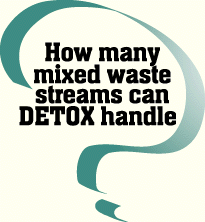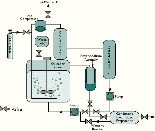


by Donald T. Robertson, Ph.D.
The U.S. Department of Energy's Office of Science and Technology is interested in developing treatment systems that can handle a wide variety of the department's mixed waste streams. In mid-August 1996, OST's mixed waste focus area plans to begin a demonstration to test the feasibility and applicability of one such technology-a chemical wet oxidation method. DETOX, developed and patented by Delphi Research, Inc. of Albuquerque, New Mexico, has the potential to destroy hazardous organics and concentrate heavy metals and radionuclides in a process solution while controlling releases of hazardous air pollutants.
DETOX is a chemical alternative to incineration. Incineration and other combustion processes have experienced permitting problems due to the public's negative perceptions of incinerators releasing hazardous contaminants into the atmosphere. Because DETOX operates at relatively low temperatures and pressures, its emissions are more easily controlled than many other thermal treatment processes. This is an advantage not only in operations, but also in permitting.
Testing will validate DETOX's capability to:
Dephi Research, with support from the mixed waste focus area, is preparing DETOX for a mid-August Phase I demonstration at DOE's Savannah River Site near Aiken, South Carolina. Successful cold testing at Savannah River will lead to treatment of actual mixed wastes (hot testing) at Rocky Flats Environmental Technology Site near Golden, Colorado in early July 1997. During Phase I and II testing, data will be gathered to determine DETOX's full range of application, equipment size, capital and operating costs, effectiveness, safety, reliability, permitability, and potential commercial application.
How it works
 The DETOX technology uses catalytic chemical
oxidation to transform complex organic compounds into carbon
dioxide and water. When chlorinated organics come into contact
with the oxidation solution, hydrogen chloride is produced in
addition to carbon dioxide and water. Nitrogen, sulfur, and
phosphorous are converted to gaseous nitrogen, sulfate ions, and
phosphate ions, respectively. Organic compounds are destroyed and
metallic species dissolve in the oxidation solution.
The DETOX technology uses catalytic chemical
oxidation to transform complex organic compounds into carbon
dioxide and water. When chlorinated organics come into contact
with the oxidation solution, hydrogen chloride is produced in
addition to carbon dioxide and water. Nitrogen, sulfur, and
phosphorous are converted to gaseous nitrogen, sulfate ions, and
phosphate ions, respectively. Organic compounds are destroyed and
metallic species dissolve in the oxidation solution.
The oxidation reaction takes place at 200 degrees Celsius and about 110 psig (pounds per square inch, gauge) in a concentrated solution of ferric chloride in dilute aqueous hydrochloric acid. The ferric ions oxidize organics to carbon dioxide and are reduced to ferrous ions. Oxygen is used to oxidize ferrous ions back to the ferric state, thus regenerating the oxidant and carrying on the oxidation cycle. Water is formed during the regeneration. Since ferric ions are regenerated rather than consumed, the oxidation reaction can be considered to be catalyic in iron.
The DETOX demonstration unit is mobile and consists of two process modules connected by process piping, a control trailer, and an oil heating/cooling module. During the demonstration, the unit will be operated 24 hours a day, five days a week. The unit will receive radioactively contaminated solids, such as paper, cotton, latex rubber, and polyethylene and polyvinyl chloride plastics. The unit will also accept liquid wastes, such as chlorinated solvents, paints and thinners, and cutting oils. Wastes will be fed into the primary reaction vessel at a maximum feed rate of 25 kilograms of organic material per hour (55 pounds per hour for solids, and 6.8 gallons per hour for liquids). Vapors from the primary vessel will be fed into the secondary reactor, which will destroy any unoxidized volatile organics and capture any volatile metals that escape the primary vessel.
The DETOX process is highly tolerant of both physical and chemical characteristics of the incoming waste stream. Even stainless steel is dissolved by the process solution in minutes at the operating temperature. Sludges and solids may be introduced to the process via pumps or slurry feeds. The DETOX unit accepts liquid wastes for treatment without any preparation; drums or tanks containing liquid wastes can be connected directly to the liquid feed station and pumped directly into the process.
Before being vented into the atmosphere, the off-gas will pass through a carbon bed to remove residual volatile organics and then through a high efficiency particulate air filter. Precipitation of the DETOX solution will concentrate the hazardous metals and radionuclides. Filtration will remove the residue, which will then be placed in lined drums for testing, solidification/stabilization, and disposal.
Partners sought
Delphi is actively seeking potential partners, licensees, and users to participate in the commercialization of the DETOX process. For more information, contact Terry Rogers, president of Delphi Research, Inc., at (505) 243-3111; fax: (505) 243-3188. For more information about the DETOX process or the demonstration, call Patrick Dhooge, vice president of Delphi Research, Inc., also at the above numbers.
Donald Robertson is the environmental compliance officer at Delphi Research, Inc.
![]()